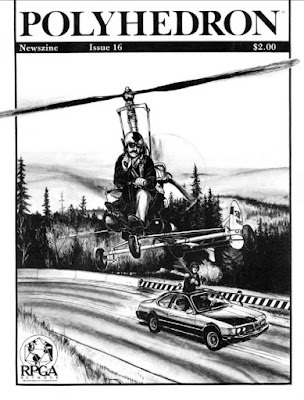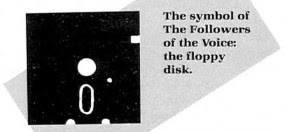Polyhedron: Issue #16
 Issue #16 of Polyhedron (February 1984) is the beginning of a couple of new features for the RPGA newszine. First and most notably, the issue includes an 8-page removable "mini-module" in its center. I'll have more to say about this shortly, because it was a fairly big deal at the time. Secondly, this issue marks the start of James M. Ward's "Cryptic Alliance of the Bi-Month" series for use with Gamma World. I was (and remain) very fond of this series, so I'll likewise have more to say about it later in this post.
Issue #16 of Polyhedron (February 1984) is the beginning of a couple of new features for the RPGA newszine. First and most notably, the issue includes an 8-page removable "mini-module" in its center. I'll have more to say about this shortly, because it was a fairly big deal at the time. Secondly, this issue marks the start of James M. Ward's "Cryptic Alliance of the Bi-Month" series for use with Gamma World. I was (and remain) very fond of this series, so I'll likewise have more to say about it later in this post.In her "... from the editor" column, Mary Kirchoff explains that the RPGA has decided to stop producing exclusive merchandise, including exclusive AD&D adventure modules. Consequently, each issue will no longer include a catalog, freeing up about ten pages for additional gaming material. This month, that means the aforementioned mini-module. Kirchoff also mentions that, with the increase in space available for game material, she's looking for more submissions from readers. This call will bear some interesting fruit in future issues.
The issue proper begins with "Encounters" by Doug Behringer. This Top Secret scenario pits "NATO agent" – whatever that means – Dean Wiles versus two GRU operatives (Mike Duplie and Gregor Campleliski – I guess these are supposed to be Russian ...) as he attempts to help an East German laser scientist defect to the West. Other than the cool illustration by Roger Raupp depicting Wiles flying a gyrocopter, there's not much to recommend this article. I wish it were otherwise, as Top Secret was a game I greatly enjoyed in my youth.
Much better is "The Followers of the Voice" by James M. Ward, which details the titular cryptic alliance for Gamma World. Ward begins the article by explaining that "90% of all the adventure that goes on in the GAMMA WORLD game" is instigated by cryptic alliances, which gives some insight into how Ward views the play of the game. For that reason, each installment of the series will provide information about history, leadership, goals, geographic locations, and legends associated with each alliance. It's a solid format and one that I appreciated back in the day. The Followers of the Voice, who worship computers, were never my favorite alliance, however, and reading this article did little to change that. Even so, there's something amusingly quaint about seeing the alliance's symbol from the vantage point of 2024:
 There's also a legend about a Follower named Jony who scatters seeds that grow into trees whose fruits are computer programs. As I said, it's all very quaint.
There's also a legend about a Follower named Jony who scatters seeds that grow into trees whose fruits are computer programs. As I said, it's all very quaint."The Shady Dragon Inn" by Carl Smith is an expansion of the Dungeons & Dragons product of the same name, providing additional details about the eponymous inn. "Hot Shots and Cold Water" by Roger E. Moore offers advice on handling "hot shot" players and their over-powered characters. This is precisely the sort of question that led Gary Gygax to create The Tomb of Horrors . For his part, Moore counsels not simply trying to humble boastful players by killing their characters but rather trying to find new and interesting ways to challenge them that don't involve combat or even game mechanics – social maneuvering, politics, religious strife, etc. He also suggests that referees consider the role their own practices may have played in creating hotshots with high-level PCs and course correcting so as to avoid the problem in the future. Like most Moore efforts, it's a good piece, filled with solid advice clearly born of years of experience.
Kim Eastland pens a pair of articles this issue. The first, "Boredom," focuses on those aspects of play that can lead to yawning during a session and how best to deal with them. He briefly covers eight sources of boredom: Impossible oddsMont Haul worldsLong-winded GMsUnprepared GMsRandom encounters GMsMap-crazed GMs or playersOverly creative GMsThe "stuck-in-a-rut" campaignSome of these problems are fairly obvious, while others are less so. For example, by "overly creative," Eastland means simply a GM who is constantly inventing new and unusual game elements that make it impossible for players to properly judge how to approach them, leading to a "why bother trying?" attitude that kills enthusiasm.
Eastland's other article, "Research is Not a Dirty Word," is a kind of alternate Appendix N, focusing primarily on non-fiction books that Eastland feels offer inspiration to harried referees. For example, the Osprey "Man-at-Arms" series is given an endorsement, as is The Dictionary of Imaginary Places. As you might expect, it's a very idiosyncratic list and regrettably short, but it's probably useful, especially to younger referees who haven't read as widely as have us oldtimers. "Photo Session," on the other hand, is just a filler article consisting of public domain NASA concept art of space platforms and lunar rovers. The accompanying text (with no listed author) attempts to connect the illustrations to Star Frontiers by offering cursory ideas of how to use them as inspiration.
"Monty Haul and the German High Command" by James M. Ward is another reprint from Dragon. It is, however, a very fun article, recounting a game of the World War II miniatures game to which fantasy elements, such as magic. Though mostly played for laughs, I found the article fascinating in the way it casually depicts the introduction of ahistorical and indeed fantastical things into a WWII game. I remember reading about many such incidents in the early years of the hobby. I'm not sure it was ever a commonplace practice, but the fact that it happened at all intrigued me, particularly given my own hidebound prejudices at the time.
"Dispel Confusion" continues to grow in size, taking up three pages in this issue. As is often the case, the questions often seem to arise out of a failure at reading comprehension. I suppose one could be more charitable and suggest that the real problem is that many rules were poorly or unclearly phrased and that's fair. RPG rulebooks have never been paragons of clarity. Still, reading these now, I find myself shaking my head at the things players actually bothered to ask TSR for "official" clarification. But that's the kind of mindset the company encoureaged and one to which I was myself sometimes prone.
Finally, there's "The Riddle of Dolmen Moor" by Bob Blake. It's an AD&D scenario that was apparently first used as part of a series of connected scenarios for use in RPGA tournaments. As a stand-alone adventure, it doesn't offer much other than fighting undead among some barrow mounds on the titular Dolmen Moor. However, it's got an interesting pseudo-Celtic flavor to it that I found intriguing at the time. It's being part of a larger narrative about the prophesied return of an ancient king was similarly novel. Consequently, I have a strange fondness for this "mini-module" and its sequels. They'd eventually all be collected into two AD&D modules that were published in 1985.
Issue #16 of Polyhedron marks, as I wrote earlier, yet another step along the road toward the transformation of the newszine into something more akin to "Dragon Jr.," albeit with its own unique flavor. I welcomed this when I was a subscriber, precisely because I was never an active member of the RPGA and cared little for keeping up with the latest news and views about conventions. I rather suspect that TSR came to understand that many of their subscribers were like me and so began to tailor Polyhedron's content accordingly. I wonder how this might have been seen by RPGA members who actually did care about cons and tournaments.
James Maliszewski's Blog
- James Maliszewski's profile
- 3 followers



